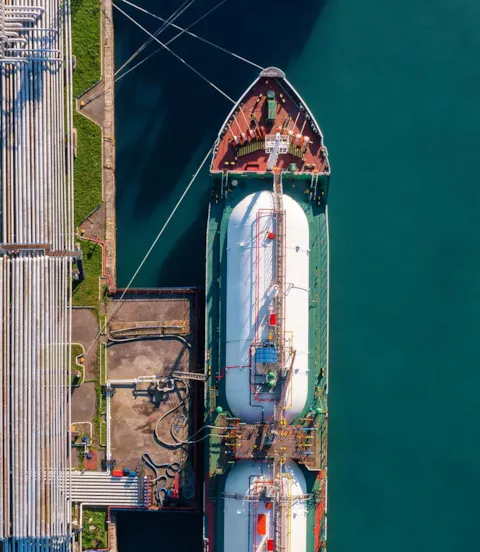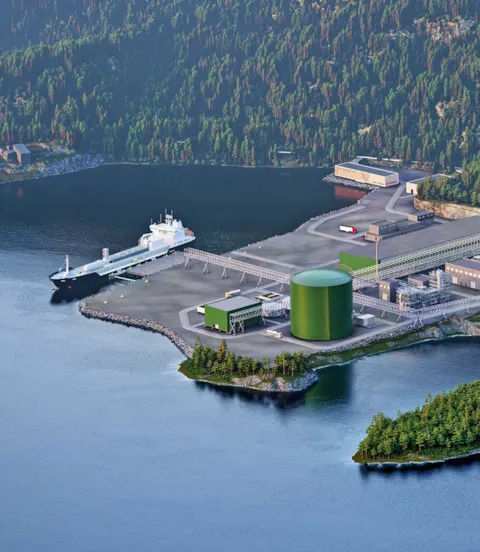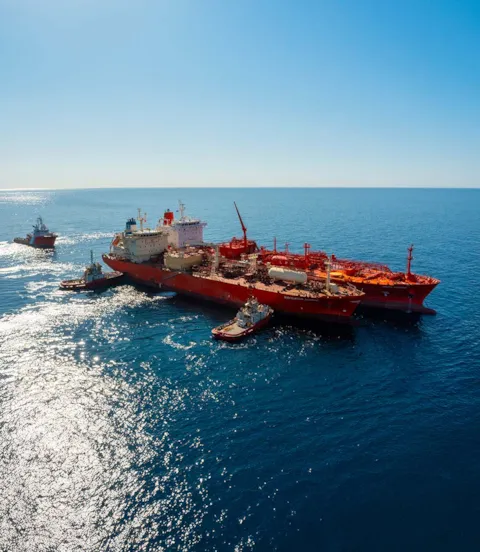Ammonia as a marine fuel: Prospects and challenges
Ammonia is gaining traction as a marine fuel, backed by regulatory progress, engine innovation and early fleet adoption. Due to high costs and infrastructure gaps, shipowners are advised to plan strategically when choosing the right future fuel. How far and fast ammonia as an alternative fuel can propel shipping decarbonization is examined in the DNV paper Ammonia in Shipping.
“The around 40 ammonia-capable ships on order put ammonia firmly in the decarbonization race,” says Linda Sigrid Hammer, Principal Consultant, Environment Advisory at DNV and lead author of the paper. “Across most barriers significant advancements have been made in the last five years, while challenges remain.” DNV’s paper analyses what it will take to get ammonia-fuelled ships approved, how to speed up the process, and practical steps for shipowners.
The paper identifies and discusses the remaining hurdles and presents them in a dashboard showing change in the status quo for ammonia fuel in 2025 compared with 2020.


Ammonia fuel rules progress
Ammonia’s toxicity requires stricter safeguards than conventional fuels. In 2020, approvals relied on risk-based case studies.
Since then, a combination of new DNV rules introduced in 2021 and updated annually and IMO interim guidelines launched in 2024 have given designers a regulatory framework to work with until binding Code amendments enter into force.
Amendments to the IGC Code (International Code for the Construction and Equipment of Ships Carrying Liquefied Gases in Bulk) allow ammonia carriers to use cargo as fuel, with draft interim guidelines recently finalized. Binding amendments to the IGF Code (International Code of Safety for Ship Using Gases or Other Low-flashpoint Fuels) are unlikely before 2032, however.

Ammonia propulsion gains ground
Five years ago, ammonia propulsion was conceptual. By August 2025, 39 ammonia- capable ships, mainly ammonia carriers and bulkers, were on order. By late 2025 or early 2026 we will also see the first deliveries of new vessels capable to burn ammonia.
Engine developers are committed. Everllence, WinGD and J-Eng are delivering dual-fuel two-stroke engines from 2025/2026, while Hyundai’s HiMSEN H22CDF-LA four-stroke has multi-class approval. Demonstrations, including Fortescue’s Green Pioneer and ammonia-fuelled tugs in Japan and China, prove operational feasibility.
Fuel-system solutions are also emerging, such as Wärtsilä’s integrated package and Alfa Laval’s FCM Ammonia. The sector has moved from theory to deployment.

How to manage ammonia’s energy density issues
Ammonia requires nearly triple the volume of marine gas oil for the same energy, reducing range and cargo space. But design strategies, dual-fuel capability and shorter bunkering intervals make the challenge manageable.
Naval architects now weigh trade-offs between capacity, range and bunkering.
“The severity of this barrier depends heavily on ship type and trading pattern,” says Hammer. “For liner services and vessels with deck space, solutions are easier. The space issue is now seen as a manageable design problem rather than a showstopper.”

High costs and fuel gaps slow ammonia adoption
Ammonia-fuelled newbuilds still typically cost 15–20% more than conventional designs, and for some retrofits even more. Although high, the additional cost remains within feasible limits, assuming other market conditions provide sufficient incentives.
Ammonia in Shipping reports studies suggest a 16% premium for a large containership, +19% for an Aframax tanker, and +15% for midsize gas carriers, while retrofitting older bulkers can be prohibitively costly at up to 60% of remaining ship value.
“Uncertainty on cost has narrowed as designs mature, but shipyards often add risk premiums for bespoke projects. Costs should fall as production scales and designs standardize, but the capital expenditure barrier is roughly as high as in 2020,” observes Hammer. “Even if ships are ready, the toughest challenges hinge on the cost barrier, in particular the fuel cost, which remains too high.”

Carbon pricing begins to close ammonia cost gap
In 2020, neither green nor blue ammonia could compete with fuel oil on cost. Green ammonia now trades at about USD 2,900 per tonne of marine gas oil equivalent (tMGOe) in Europe, about five times the price for MGO. Blue ammonia entered the market only recently and in small volumes.
Forecasts suggest costs for ammonia could fall to 1,000–1,900 USD/tMGOe by 2050, approaching parity with MGO under carbon pricing. The EU Emissions Trading System (2024), FuelEU Maritime Regulation (2025) and a potential forthcoming IMO mechanism could tilt the price balance. The gap remains large, but is narrowing.

First-generation infrastructure in place
In 2020, ammonia bunkering did not exist. By 2025, demonstrations in Australia, China, Japan, the Netherlands, Singapore and the UK have proven safe transfers.
Major ports are preparing: Rotterdam completed a large pilot transfer in 2025, Singapore and Rotterdam rate themselves at Port Readiness Level 6–7, and Norway has received permission to build a terminal. Japan has ordered the first dedicated bunkering vessel for 2027.
Ammonia carriers could drive adoption. In 2024, 274 carriers moved cargo from 38 terminals, nearly half of new orders being ammonia-capable. This logistics base could support early green corridors.
“While ammonia bunkering infrastructure has yet to materialize, the barrier level has been significantly lowered, reflecting all the preparations and demonstrations being carried out in several different parts of the world and in various segments,” says Hammer.

How can the supply of ammonia fuel be accelerated?
The transition unfolds in three phases: preparation, upscaling and stabilization. Preparation is under way, building a small pioneering fleet, training crews, and developing initial bunkering infrastructure.
Key barriers such as safety frameworks and port readiness are now low enough for this fleet to emerge. The critical obstacle remains fuel price. DNV’s paper suggests that temporary financial support mechanisms will be needed.
Hammer says: “Upscaling will require standardized frameworks and global carbon pricing to unlock investment in large-scale production. Parallel advances in fuel technologies, infrastructure and training are essential. Public–private partnerships and ammonia’s existing industrial base could accelerate progress.”

How shipowners can assess ammonia technically and economically
For shipowners, the challenge is choosing the right low-GHG fuel amid uncertain regulations and costs. Options – biodiesel, methane, methanol, ammonia – all pose risks for operations, asset value and compliance, but so does continuing with the status quo.
Ammonia in Shipping proposes a two-step framework. First, economic analysis: test long-term profitability under fuel and carbon price scenarios, regulations and availability, with sensitivity analysis to capture uncertainty. Second, technical analysis: examine design and operational impacts, including storage, bunkering, tank layouts and safety. Fuel-ready newbuilds, enabling later conversion, are recommended.
DNV offers support through its Fuel Selector service and Ammonia as a Marine Fuel Safety Handbook.

Seven steps to regulatory approval
For owners choosing ammonia, approval is complex but achievable. Ammonia in Shipping outlines a seven-step pathway for design, approval and safe operations.
“Together, these approaches give shipowners structured decision support and practical guidance for deploying ammonia-fuelled vessels,” Hammer concludes. “This paper shows a path ahead for ammonia to fulfil its potential as a decarbonization option for deep-sea shipping.”
- Shutterstock / artem evdokimov
- DNV
- Fortescue
- Yara